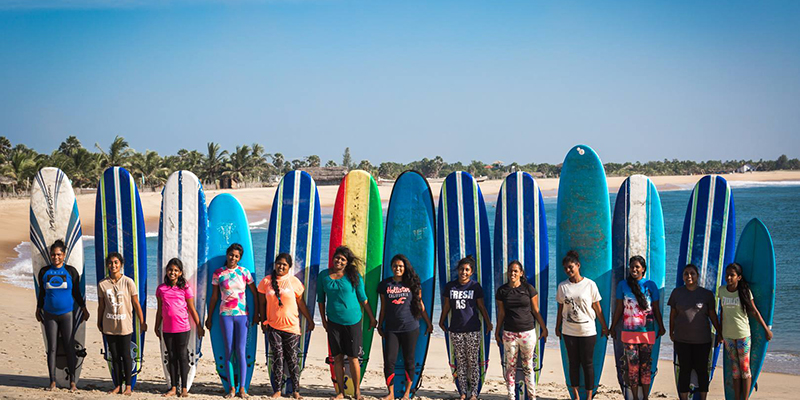“Women’s surfing also has taken off in Arugam Bay. There’s a group of women now and they are really empowering these kids to come out and practice surfing, removing the taboos around it from it being a man’s sport. They are all local women from Pottuvil and other areas around the East Coast.”
Wasim Amsal
5 to 10 years ago, if you asked any Sri Lankan about the Eastern Coast of the island, their first thoughts would be “fisheries” or “The Trincomalee Harbour.” And it can be agreed that back then, destinations embedded in the East Coast were not as popular, compared to the South Coast or the Central Province of Sri Lanka.
Taking into account that much of the Eastern Province was under the threat of the LTTE during the civil war and the fact that the travel time to destinations in the East Coast is much longer from Colombo, many locals and international tourists were hesitant to experience the beauty beheld by the Eastern Province.
However, that may be changing rapidly nowadays, as the travel destinations in the East Coast are starting to take centre stage and grabbing many people’s attention.
We at Team Pulse spoke to Hospitality Consultant, Wasim Amsal, with hopes of obtaining insight as to how the culture and the environment in destinations of the East Coast are shifting rapidly these days, from it being known for a province that generates seafood and paddy, to one of the most attractive tourist destinations in the world.
A positive shift in tourism and the job market
Even though 2019 and 2020 were not the best years for the tourist industry in the East Coast, due to the Easter bombings in 2019 and the Coronavirus outbreak in 2020; tourism in the East saw a significant boom from 2016 – 2018, with many tourists and local travellers, focusing their attention more on the destination.
A bounce back in tourism is anticipated as the travel restrictions within the country and around the world are slowly reducing with time. The East Coast is marvelled upon, for their beautiful sandy beaches, the coral reefs in Pigeon Island, safari and wildlife at the Kumana National Park and of course, engaging water sports and other activities like surfing, diving and snorkelling.
Many new establishments are still coming in and businesses are investing in new projects in the East Coast. Many of them are hotels and restaurants to accommodate the influx of tourists and travellers who enter the East Coast during the season. The nightlife in some areas of the east coast is also improving with time, providing tourists with more options for entertainment during their stay.
Almost all of the current and new establishments in the East Coast are recruiting locals from surrounding areas and providing them with proper training and development, helping them improve their skills significantly, paving the way for them to reap the benefits out of higher standards of living.
“Not only the big establishments but the local taxi federation is also profiting from tourism. Tourists usually use three-wheelers and taxis to transport their surfboards to and fro, because Arugam Bay is pretty spread out and the surf points are at least a kilometre or two apart. And surfboards can’t be mounted on bikes so the three-wheelers and taxis are making good money there.” Wasim explained.
Introduction of new sports to the Sri Lankan culture
As you may have already heard, Arugam Bay is becoming quite popular among professional surfers and surfing enthusiasts and many tourists come to Arugam Bay for the sole purpose of riding the salty waves.
This has paved the way for Arugam Bay to become one of the destinations to host the ‘So Sri Lanka Pro’ professional surfing championship, organised by the World Surf League and the Surfing Federation of Sri Lanka, with over 120 surfers from 24 countries across the world, participating in the event. This event also provides great opportunities for local surfers to take on international surfing pros and learn from and build connections with many other professionals.

In 2018, 27-year-old Leshitha Prabath was crowned as National Surfing Champion, after battling for the trophy for two days at a local event named “National Surfing Championship Series” in Arugam Bay. He was titled champion as he showcased strong skills of speed, power, flow and a solid aerial.
What’s more is that even though surfing is considered to be a ‘man’s sport’ by many, the first officially-registered female surf club, ‘The Arugam Bay Girls Surf Club’ is here to change the game and normalise sports to be enjoyed by any enthusiast, irrespective of gender. This all-female surf club consists of a small yet growing group of 17 women, led by Shamali Sanjaya. They often organise surf trips to improve their skills and beach cleanups to help keep the environment clean and safe. They hope to keep empowering women who are surfing enthusiasts to learn, regardless of the negative comments from society, paving the way for women to be able to create job opportunities by teaching tourists to surf and for equality to be normalised.
The shift in eco-friendly measures in the East
“People in the East are a little more green, they don’t encourage the use of plastic anywhere. A lot of recycling plants and upcycling projects have been established in Arugam Bay and other areas that recycle any plastic items that you have. It is an encouraging prospect, I would say, compared to the South” Wasim stated.
One such establishment is Waste Less Arugam Bay (WLAB), where their entire setup is housed in re-purposed shipping containers, making it easily movable and reproducible. This concept is proven to be a success, where they could easily move and/or reproduce their lab in any tourist destination in Sri Lanka, where the demand for waste management is high. Their aim is to influence the behaviour of school children, local business owners and tourists about the adversities of plastic pollution. They have provided tourists and travellers with a water filtration system that can be accessed by anyone as an alternative to purchasing plastic bottles of water. Visitors can refill from their water filtration system and they are also educated about the number of resources that are needed to create virgin plastic bottles. They also collect plastic bottles and other plastic items from areas surrounding Arugam Bay, transport it to their synthetic yard production factory in Horana, where the PET plastic pellets are turned into 100% recycled plastic polyester yarn.
There are other establishments like the WLAB striving to protect the environment and conserve marine life in other destinations of the East Coast, like the Pigeon Island.
Although the East Coast was previously known for fishing and cultivation, this shift towards embracing new sports, becoming a tourist hub and establishing eco-friendly measures seems to be a positive one. The Coast’s progress and outlooks may just be what we need as Sri Lankans, to hope for our little island to continue to shine like the pearl it is, amongst the rest of the world.
The post The Shifting Culture in the East Coast of Sri Lanka appeared first on Pulse.
Source From Pulse.lk
Author: Senuri Wasalathanthri
#SriLanka #News #lka



